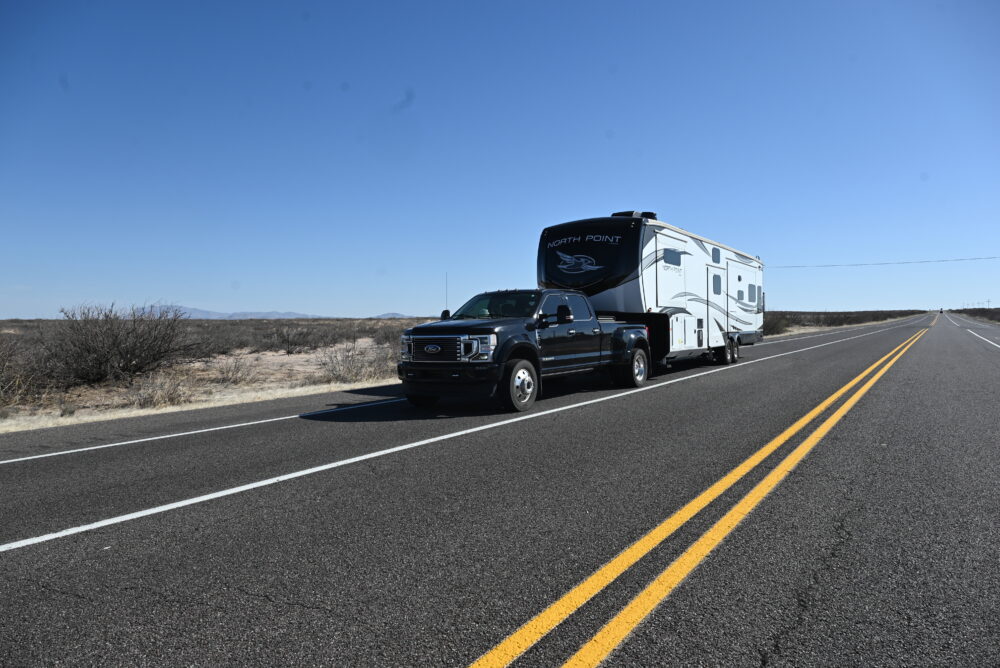
Stay Safe While Driving Your RV In Crosswinds
Crosswind safety is a crucial aspect of driving an RV. Strong crosswinds can cause instability and make it difficult to control your vehicle. In this guide, we will discuss some important tips and techniques to keep your RV stable on the road, ensuring a safe and comfortable journey.
What are crosswinds?
Crosswinds are created when winds coming from different directions meet. These winds can cause turbulence and create instability for drivers, especially those in RVs. To stay safe, it is important to understand the factors that contribute to crosswinds and how they can affect your driving.
Factors that contribute to crosswinds
There are several factors that can influence how strong a crosswind is, as well as how much it affects your RV. These include:
- Seasonal weather patterns
- Location of the vehicle
- Elevation
- Terrain
- Nearby bodies of water
- Surrounding vegetation
- Wind speed and direction
- RV size and weight
- Aerodynamics of the RV
Effects of crosswinds on RV stability
Crosswinds can have a significant effect on the stability of your RV while driving. The effects of crosswinds on RV stability can be seen in the following ways:
- Swaying and rocking motion
- Difficulty in maintaining lane position
- Increased risk of accidents
Preparing your RV for crosswinds
Crosswinds can be a dangerous hazard for RV drivers. However, there are ways to prepare your RV and stay safe while driving. Properly prepared RVs can handle crosswinds with ease and keep you and your passengers safe.
Properly load and balance your RV
To ensure your RV is prepared for crosswinds, there are several important steps you should take. First, make sure your RV is properly loaded with the right amount of weight and evenly distributed. This is important because an overloaded or unevenly loaded RV can be more susceptible to the effects of crosswinds.
Second, check your RV’s suspension and make sure it is in good condition. An improperly-maintained suspension can make your RV more vulnerable to crosswinds.
Check your RV tires
In addition to all the other maintenance tasks, it is crucial to regularly check the condition of your RV tires. This is because underinflated or worn tires can significantly increase the vulnerability of your RV to crosswinds.
Crosswinds can have a significant impact on the stability of your RV. When your tires are not properly inflated, they may not have the optimal grip on the road. This lack of grip can make it harder for your RV to maintain its course when faced with strong crosswinds.
Furthermore, worn tires have reduced tread depth, which affects their ability to provide adequate traction on the road. Tires with worn treads are more likely to slip or lose grip, especially in challenging weather conditions. As a result, your RV becomes even more susceptible to the influence of crosswinds.
To ensure your safety and the stability of your RV, it is essential to regularly inspect your tires for signs of wear and tear. Look for any visible signs of damage, such as cracks, bulges, or uneven tread wear. Additionally, make sure to check the tire pressure regularly and inflate them to the recommended levels. Properly inflated tires ensure optimal grip and reduce the risk of instability caused by crosswinds.
If you notice any issues with your tires, such as low pressure or excessive wear, it is important to address them promptly. Consider replacing worn tires with new ones that have sufficient tread depth to ensure maximum traction. By maintaining proper tire condition, you can minimize the impact of crosswinds on your RV and enhance overall road safety.
Slow down
When encountering crosswinds while driving, it is important to adjust your speed accordingly. Lowering your speed will provide better control over your vehicle, reducing the chances of being affected by the strong gusts.
In addition, by keeping both hands firmly on the wheel, you can quickly respond and correct any drifting caused by the crosswinds. This ensures that you maintain your intended path and prevent any potential accidents or loss of control.
Stay alert
In order to ensure your safety and well-being, it is crucial to remain vigilant and attentive to the environment around you. By staying alert, you can promptly respond to any unexpected or potentially dangerous situations that may arise.
Being aware of your surroundings means actively observing and evaluating the people, objects, and activities happening in your vicinity. This heightened sense of awareness enables you to anticipate potential risks and take necessary precautions, such as avoiding certain areas or adjusting your behavior accordingly. It also allows you to identify any potential threats or suspicious individuals in your surroundings, giving you the opportunity to take appropriate action, such as seeking assistance or removing yourself from the situation.
By staying alert and being aware of your surroundings, you are equipping yourself with the necessary tools to react quickly and effectively in case of any unforeseen circumstances. This proactive approach can significantly reduce the likelihood of becoming a victim and help ensure your overall well-being.
Reduce wind resistance
Reducing wind resistance in your RV is a crucial aspect of managing crosswinds while driving. One effective method is to close all roof vents, windows, and skylights before hitting the road. This minimizes the openings through which the wind can enter, reducing the chances of your RV getting buffeted by strong crosswinds.
Furthermore, keeping your RV well-maintained, including checking for loose components and ensuring a properly functioning suspension system, will contribute to a smoother and safer ride when encountering crosswinds. These measures, combined with attentive and cautious driving, can greatly enhance your RV’s ability to handle challenging wind conditions while on the road.
Driving techniques for crosswinds
Maintain a steady speed
Maintaining a steady speed is paramount. Sudden acceleration or deceleration can lead to instability, especially in gusty wind conditions. Instead, aim to maintain a consistent speed that you’re comfortable with, which helps in keeping your RV’s handling predictable.
If your RV is equipped with cruise control and you’re on a relatively straight and level stretch of road, consider using it. Cruise control can help you maintain a steady pace, which is particularly useful when you need to concentrate on maintaining control in crosswind situations. However, always stay vigilant and ready to override cruise control if wind conditions change abruptly. Your active control remains crucial for safe RV handling in crosswinds.
Keep a firm grip on the steering wheel
When driving your RV in crosswinds, it is crucial to maintain a firm grip on the steering wheel. The force of crosswinds can be strong and may try to push your vehicle off course, so it is important to have a strong hold on the wheel to counteract this. By keeping a firm grip, you can effectively steer your RV and maintain control even in challenging wind conditions.
Using both hands on the steering wheel is essential when dealing with crosswinds. This allows you to have maximum control over the vehicle and make quick adjustments if necessary. By using both hands, you can distribute the force evenly and react promptly to any sudden gusts of wind that may affect the stability of your RV. It also helps to have a better grip, ensuring that your hands do not slip off the wheel during unexpected wind gusts.
While it is important to make necessary adjustments to counteract the effects of crosswinds, it is equally important to avoid overcorrecting. Overcorrecting can lead to instability and potentially cause your RV to veer off course or even lose control. It is crucial to make smooth and controlled movements with the steering wheel to maintain stability and prevent any sudden and drastic changes in direction.
In summary, maintaining a firm grip on the steering wheel, using both hands, and avoiding overcorrections are key strategies for successfully driving an RV in crosswinds. These techniques will help you maintain control and ensure the safety of yourself, your passengers, and other drivers on the road.
Drive in the center of the lane
When driving an RV in crosswinds, it is crucial to stay in the center of the lane. Crosswinds can easily push a large and tall vehicle like an RV off course. By staying in the center of the lane, you provide yourself with a buffer zone on either side, reducing the risk of being pushed into adjacent lanes or off the road.
To help maintain your position, it is recommended to use reference points on the road. These reference points can be fixed objects or landmarks that you can visually align your RV with. For example, you can use the edge of the road, lane markings, or even trees or signs along the side of the road as reference points. By keeping your RV aligned with these points, you can better gauge any drift caused by crosswinds and make necessary adjustments.
In some cases, you may need to adjust your position while driving in crosswinds. Strong gusts or changing wind conditions can affect the stability of your RV and require you to make minor corrections to stay centered in the lane. These adjustments can be made by gently turning the steering wheel in the direction opposite to the wind gusts, allowing you to counteract their force and maintain control of your vehicle.
Overall, staying in the center of the lane, using reference points, and making necessary adjustments are essential techniques for driving an RV in crosswinds. These practices help ensure your safety, prevent accidents, and maintain control of your vehicle.
Be careful when passing or being passed by large vehicles
When driving an RV in crosswinds, it is extremely important to exercise caution when passing or being passed by large vehicles. The size and height of these vehicles, such as trucks or buses, can create a significant wind resistance that can affect the stability of your RV. Therefore, it is crucial to be aware of this potential hazard and take appropriate measures to ensure your safety.
One of the key precautions to take is to increase your following distance. By maintaining a greater distance between your RV and the other vehicle, you allow yourself more time and space to react to sudden gusts of wind. This added buffer zone reduces the chances of your RV being affected by the turbulence created by the passing vehicle.
Plan your trip with RV LIFE Trip Wizard
RV LIFE Trip Wizard is a valuable tool for RV-safe trip planning. Under Map Settings, you can find Weather Layers, specifically the Windspeed feature, where you can gain critical insights into the wind conditions along your route. This allows you to proactively plan for crosswinds, making informed decisions on your travel day.
With access to current wind speed data, you can identify potential high-wind areas and adjust your route or driving strategy accordingly, ensuring a safer and more comfortable journey. RV LIFE Trip Wizard empowers you with the information you need to navigate crosswinds with confidence and precision.
Additional tips for crosswind safety
Be aware of weather conditions
- Check weather forecasts before your trip
- Re-route or avoid driving in severe crosswind conditions if possible
Consider using a crosswind stabilizer
- Install a sway control system
- Consult with an RV specialist
Conclusion
In conclusion, driving an RV in crosswinds requires caution, increased following distance, and preparedness for wind gusts. By being aware of potential hazards and taking appropriate actions, you can ensure a safer and more enjoyable driving experience. Remember to always prioritize your safety and the safety of others on the road.
Get RV-safe directions
For all of your trip planning needs, look no further than RV LIFE Campgrounds and RV LIFE Trip Wizard. Campground Reviews is a trusted source of campground reviews offered by RV enthusiasts. Along with the RV LIFE App, RV Trip Wizard gets you to your destinations utilizing routes specific to your travel preferences.



